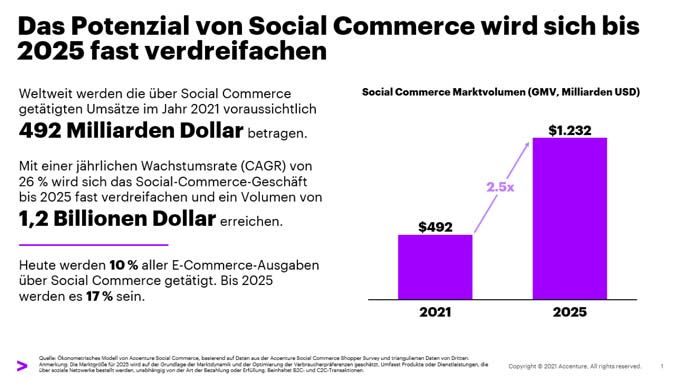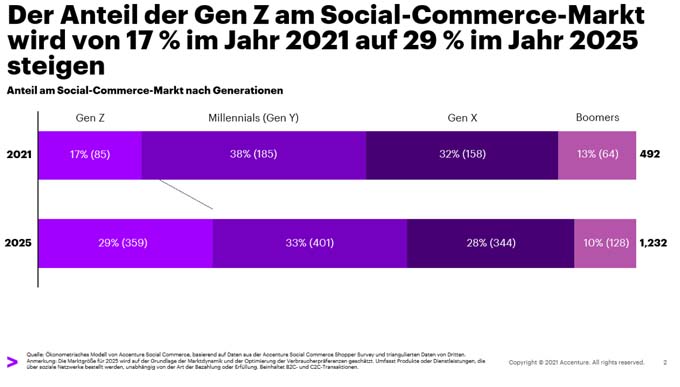Social media shopping: volume of $1.2 trillion expected by 2025
By 2025, social media shopping will grow globally three times faster than traditional e-commerce to $1.2 trillion. Generations Y and Z in particular are driving this growth.

In the study "Why Shopping's Set for a Social Revolution," the consulting firm Accenture looks at the market potential of social commerce. The term "social commerce" covers a person's entire shopping experience, from product discovery to the final purchase transaction, which takes place on a social media platform. Nearly two-thirds (64%) of social media users surveyed said they had made a social commerce purchase in the past year, which Accenture estimates equates to nearly two billion social commerce consumers worldwide.
Pandemic also fuels social media shopping
The fact that social platforms serve as an entry point for online activities and that users consume news, entertainment and communication offerings there was demonstrated once again not least by the pandemic. The continuous increase in the amount of time users spend on social media underscores the importance of online platforms in everyday life. This also influences people's buying behavior. This opens up new revenue streams and opportunities for platforms and brands to design user experiences.

Attractive for smaller brands
Smaller brands and individual companies can benefit from this development. 54% of the surveyed social media users:inside expressed that they would like to support small and medium-sized businesses when purchasing via social commerce sites. At the same time, 64% and 57% of the respondents, respectively, said that they would rather buy something for themselves when buying through social commerce platforms, considering the same sellers:ins or influencers:ins. This confirms the importance and potential of correct positioning on social commerce platforms.
"Social commerce can make it easier for smaller brands and individual entrepreneurs to creatively engage with customers, while also requiring big brands to rethink traditional e-commerce strategies," said David Holtmann, Accenture's managing director for consumer goods and services. "The right approach to social commerce requires manufacturers, sellers and brands to take their products and services to where consumers are and will be. A dynamic ecosystem is emerging in which platforms, marketplaces, social media and influencers interact. Data and expertise should be shared. This is the only way to create the right incentives for customers and offer the best customer experience in an integrated digital marketplace."
Create trust
Despite the upward trend in social media shopping, half of the social media users surveyed are concerned that purchases are not adequately protected or refunded when necessary. A lack of trust is thus becoming the biggest obstacle to the new sales channel, similar to the situation at the beginning of e-commerce.

"One of the main reasons for the reluctance to engage in social commerce to date is the lack of trust in the credibility of providers. Active social commerce users point to inadequate guidelines for returns, refunds or exchanges and see room for improvement here," says Holtmann. "Lack of trust is a problem that can only be overcome slowly. However, sellers:inside that focus on these consumer:inside concerns are in a better position to gain market share."
Who buys what in social media shopping?
Accenture predicts that by 2025, most purchases via social media shopping worldwide will be in apparel (18%), consumer electronics (13%), and home textiles (7%). In China, fresh food and snacks are also among the big product categories, accounting for 13%. Cosmetics and personal care, while smaller in terms of total social commerce sales, will quickly gain ground on traditional e-commerce. This category is expected to account for over 40% of digital spend on average in the major markets by 2025.
Source and further information: Accenture









